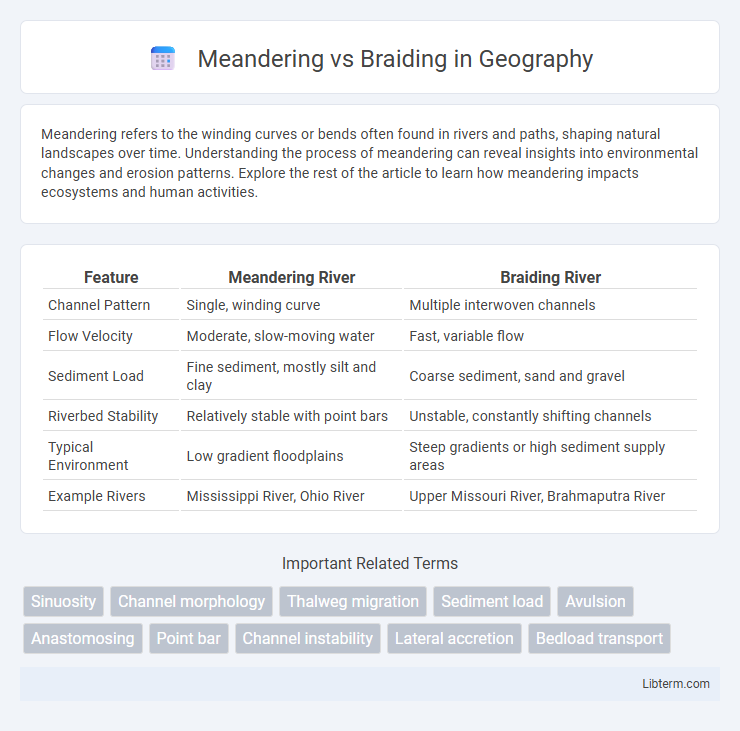Meandering refers to the winding curves or bends often found in rivers and paths, shaping natural landscapes over time. Understanding the process of meandering can reveal insights into environmental changes and erosion patterns. Explore the rest of the article to learn how meandering impacts ecosystems and human activities.
Table of Comparison
| Feature | Meandering River | Braiding River |
|---|---|---|
| Channel Pattern | Single, winding curve | Multiple interwoven channels |
| Flow Velocity | Moderate, slow-moving water | Fast, variable flow |
| Sediment Load | Fine sediment, mostly silt and clay | Coarse sediment, sand and gravel |
| Riverbed Stability | Relatively stable with point bars | Unstable, constantly shifting channels |
| Typical Environment | Low gradient floodplains | Steep gradients or high sediment supply areas |
| Example Rivers | Mississippi River, Ohio River | Upper Missouri River, Brahmaputra River |
Introduction to River Channel Patterns
River channel patterns primarily include meandering and braiding, distinguished by their flow dynamics and sediment transport. Meandering rivers exhibit sinuous, looping curves formed by erosion and deposition along banks in low-gradient areas, while braided rivers consist of multiple interwoven channels separated by temporary sediment bars, typically found in high sediment load environments. Understanding these patterns is crucial for predicting river behavior, managing flood risks, and planning sustainable riverine ecosystems.
Defining Meandering Rivers
Meandering rivers are characterized by their sinuous, winding channels that develop as water erodes the outer banks and deposits sediment on inner banks, creating distinct curves called meanders. These rivers typically form in low-gradient landscapes with fine sediment and stable flow regimes, promoting lateral migration and the development of floodplains. The dynamic equilibrium between erosion and deposition defines meandering rivers, shaping diverse aquatic habitats and influencing sediment transport.
Understanding Braided Rivers
Braided rivers consist of multiple interwoven channels separated by unstable, sediment-rich bars that constantly shift due to high sediment load and variable water flow. These rivers typically form in areas with abundant sediment supply, steep gradients, and fluctuating discharge, leading to a dynamic network of channels that frequently split and merge. Understanding braided river dynamics is crucial for predicting sediment transport, managing flood risks, and preserving aquatic habitats in regions influenced by these complex fluvial systems.
Key Differences Between Meandering and Braided Rivers
Meandering rivers feature a single, sinuous channel that curves extensively across floodplains, whereas braided rivers consist of multiple interwoven channels separated by temporary sediment bars. Meandering rivers typically form in regions with gentle slopes and fine sediment, promoting lateral erosion and point bar deposition, while braided rivers develop in areas with steep gradients and abundant coarse sediment, leading to frequent channel shifting and sediment reworking. The key differences lie in channel pattern, sediment load, flow variability, and geomorphic processes driving river morphology.
Geomorphological Processes Involved
Meandering rivers form through lateral erosion and deposition processes, where flow velocity variations cause sediment transport and point bar development, leading to sinuous channel patterns. Braided rivers emerge from high sediment load and variable discharge, resulting in multiple interwoven channels separated by transient bars formed through rapid sediment deposition. Both geomorphological processes reflect dynamic interactions between sediment supply, flow regime, and channel slope influencing river morphology evolution.
Factors Influencing River Patterns
River patterns like meandering and braiding are primarily influenced by sediment load, water discharge, and channel slope. Meandering occurs in rivers with low sediment load, gentle slopes, and stable banks, promoting sinuosity and lateral erosion. Braiding develops in rivers carrying high sediment loads with variable discharge and steeper gradients, leading to multiple interwoven channels and frequent channel shifts.
Ecological Impacts of Meandering and Braiding
Meandering rivers create diverse habitats by forming oxbow lakes, wetlands, and floodplains that support rich biodiversity and enhance water quality through sediment retention. Braided rivers, characterized by multiple interconnected channels, foster dynamic environments with high sediment transport, promoting species adapted to unstable substrates but often leading to lower overall habitat stability. The ecological impact of meandering systems generally supports more stable and productive ecosystems, while braiding systems contribute to habitat heterogeneity crucial for specialized aquatic and riparian species.
Human Interaction and River Management
Meandering rivers, characterized by their winding curves, often necessitate careful human interaction to prevent erosion and flooding near settlements, with river management strategies including bank stabilization and controlled dredging. Braided rivers, distinguished by multiple interweaving channels, pose challenges for infrastructure development and require dynamic management approaches such as adaptive floodplain zoning and sediment management to accommodate sediment deposition and channel migration. Effective river management must incorporate hydrological data and community engagement to balance ecological preservation with the protection of human livelihoods along both meandering and braided river systems.
Case Studies: Examples of Meandering and Braided Rivers
The Mississippi River in the United States exemplifies a meandering river, characterized by its sweeping bends and point bars formed through sediment deposition and erosion processes. In contrast, the Brahmaputra River in India and Bangladesh demonstrates a braided river system, with multiple interwoven channels separated by transient sediment bars due to high sediment load and variable flow. These case studies highlight how geological conditions and sediment dynamics influence river morphology and channel patterns.
Conclusion: Importance of Channel Pattern Classification
Accurate classification of channel patterns such as meandering and braiding is crucial for effective river management, flood prevention, and ecological conservation. Understanding these distinct fluvial processes helps predict sediment transport, habitat diversity, and channel stability, directly influencing engineering and environmental restoration efforts. Integrating remote sensing and geomorphological analysis enhances the precision of channel pattern identification, supporting sustainable watershed management.
Meandering Infographic

 libterm.com
libterm.com